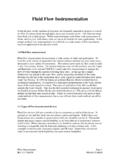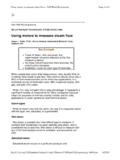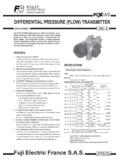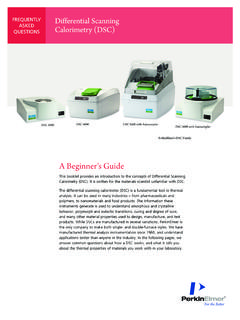Transcription of Measurement of Valve Leakage Rate using Acoustic …
1 Measurement of Valve Leakage Rate using Acoustic Emission Watit Kaewwaewnoi*, Asa Prateepasen**, Pakorn Kaewtrakulpong* *Department of Instrumentation and Control System Engineering **Department of Production Engineering King Mongkut s University of Technology Thonburi Email: and ABSTRACT This paper presents a novel method to measure Leakage rate of gas through Valve using Acoustic Emission (AE) technique. A set of various sizes of ball Valve , varied from one to three inches, was tested with a range of Valve -inlet pressure. Leakage rate through Valve was carried out by calculating the pressure difference in a chamber. An AE sensor was mounted on the case of the Valve to capture the AE signal. The AE signal was then amplified and filtered and fed into a Vector Signal Analyzer, model HP 89410A.
2 The sampling rate of the analyzer was set at 10 MHz. AE parameters which correlated with Leakage rate were identified. AE average signal level (ASL) and AE root mean square (AErms) exhibited high correlation with the Leakage rate. Finally an equation to relate the detected AE signal to the Leakage rate at different Valve -inlet pressures and Valve sizes was established. Keywords: Valve Leakage , Leakage Rate Measurement , Acoustic Emission 1. INTRODUCTION Leakage of Valve in industry such as refineries, petrochemical and nueclear plant causes high expense in a large sum annually. In general, Valve Leakage detecting using hydrostatic or pneumatic test, which may require partly or totally shutdown, is normally applied and most plants decide to schedule the Valve checking annually.
3 However, the leakages may occur before the maintenance which could cost a huge lost due to contamination and lowering the efficiency of the instrument and system. Acoustic Emission (AE) is a Non-Destructive Testing (NDT) method utilized in a wide variety of applications. This method was well accepted and commonly found in industries because of its simplicity and convenience to use. In the last decade, the attempt to implement an AE system to detect Valve Leakage was studied and developed by many researchers. Bezn [1] and Joon-Hyun Lee et al [2] suggested that AErms could be used to determinate the open and close positions of valves , such as relief and safety valves , and also to indicate aging and degradation of check valves in nuclear power plants. Pollock et al [3] studied the characteristic of Acoustic leak signals owing to the gas Leakage through a ball Valve in frequency domain.
4 As a consequence, the correlation between the AE and the Leakage rate was presented. Dickey et al [4] found that the peak amplitude of AE signal in frequency domain is independent of leak part or Leakage rate but dependent on transducer response and Valve geometry. However, they did not describe the relationship between AE parameters and Valve Leakage rate which is the primary basis for predicting Leakage rate by AE method. The primary objective of this paper is to present the relationship between AE parameters and the Leakage rate of Valve at various Valve sizes and inlet pressures. The equation utilized to find out the Leakage rate at different Valve sizes and inlet pressures was also established. 2. THEORY Acoustic Emission Acoustic emission (AE) is an energy emitted in the form of transient elastic wave or sound wave within material.
5 The AE signal is obtained using AE equipment after the sound wave has been detected and processed electrically. Generally, the AE signal has a wide frequency range of 25 kHz to 3 MHz. However, it is normally analyzed and processed in the frequency range between 100 kHz to 1 MHz due to high sensitivity. Source mechanisms of AE signal have been classified into two classes. One is called the classical sources which are originated from its macro (such as deformation or crack) and micro structures (such as slip, and twinning etc.). The other is called pseudo sources that do not release the AE directly within the material, but from external mechanisms, for instance, friction from rotating bearing and Leakage of gas or liquid [5]. In this paper, AE signal is generated by a pseudo source received from gas Leakage through poorly seated ball valves of three different sizes.
6 The type of this AE signal is a continuous AE signal since the beginning and the end of the signal (in time domain) cannot be identified. Leakage Mechanism The basic mechanism generating AE signals in a leaking Valve is the decay of turbulence resulting from the high pressure, high velocity of fluid flow. The degree of turbulence is predicted by the Reynolds number (R) defined as [3] rR = (1) where is the density, the flow velocity, r the radius of flow path and the viscosity. It has been found that the onset of turbulence occurs when the Reynolds number is between 1,000 and 10,000 giving Leakage produce an Acoustic emission. The actual detection of the Leakage depends on the flow rate as this factor decides the energy contents of the leak signal.
7 Then, a volumetric flow rate (V) can be calculated by Poiseuille formula which can be written as [3] LprV84 = (2) where p is the differential pressure across the Leakage area which has length L and radius r. The AE signal of leaking Valve is more obviously identified on the downstream side of a Valve . This is due to the turbulence created when the gas flows from the high pressure side, through the Leakage area to the low pressure side. Hence, AE sensors should be located at the downstream side of the valves [5]. The best mounting position of AE sensor on a Valve is shown in Fig. 1. Fig. 1: The best position of AE sensor on valves . AE System and Parameters Typical AE system comprises of several AE electronic modules such as AE sensors, preamplifiers, filters, amplifiers, and a data acquisition system [6].
8 AE sensors are generally piezoelectric (PZT) devices that transform elastic waves into electrical signals. To obtain the best Leakage Measurement system, appropriate signal conditioning and processing is required. Furthermore, signal to noise ratio and suitable AE parameters need to be prudently considered. A proper AE sensor must to be appropriately selected to receive the highest sensitivity. The suitable preamplifier level is based on signal source level and the saturation limits of the AE system. In order to eliminate back ground noise, a band-pass filter operated in the range of 100 kHz to 400 kHz [3] is normally used. For continuous AE signal, the most frequently used AE parameters are the average energy (AErms) and the Average Signal Level (ASL).
9 The AErms is the root mean square value of the AE signal. Since Acoustic Emission activity is attributed to rapid releases of energy in the material, the energy content of the Acoustic emission signal is related to this energy release. AErms can be defined as 0022111()( )tTNntAErmsv t dtv nTN+=== (3) where v is the voltage signal from an AE sensor, t0 the initial time, T the integration time of the signal, and N the number of discrete AE data within the interval T. Another AE parameter which is often used is the Average Signal Level (ASL) defined as 00()111()( )tTNvntASLv t dtv nTN+=== (4) 1log20vdBASLASL= (5) where ASLv is an average signal level in volts and ASLdB an average signal level in decibel (dB).
10 3. EXPERIMENTAL SET-UP The experimental set-up is illustrated in Fig. 2. Three sizes of the ball Valve which are 1, 2 and 3 inches in diameter were used in our experiment. Air was selected instead of gas due to its ease of use and safety. The level of the inlet pressure was supplied by an air compressor and controlled by a regulator. A pressure gauge with a resolution of bar with an air filter was connected to a pipe. The size of the pipe was also changed to fit with the size of each Valve . The Valve inlet pressure was varied from 1 to 5 bars with an increment of 2 bars. As mentioned earlier, the volumetric flow rate can be computed using the equation (2). However, to simplify the Measurement of the Leakage rate, a known-volume chamber was connected to the end of the Valve .







